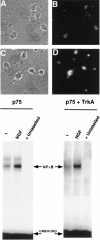Competitive signaling between TrkA and p75 nerve growth factor receptors determines cell survival
- PMID: 9547236
- PMCID: PMC6792655
- DOI: 10.1523/JNEUROSCI.18-09-03273.1998
Competitive signaling between TrkA and p75 nerve growth factor receptors determines cell survival
Abstract
In addition to its role as a survival factor, nerve growth factor (NGF) has been implicated in initiating apoptosis in restricted cell types both during development and after terminal cell differentiation. NGF binds to the TrkA tyrosine kinase and the p75 neurotrophin receptor, a member of the tumor necrosis factor cytokine family. To understand the mechanisms underlying survival versus death decisions, the TrkA receptor was introduced into oligodendrocyte cell cultures that undergo apoptosis in a p75-dependent manner. Here we report that activation of the TrkA NGF receptor in oligodendrocytes negates cell death by the p75 receptor. TrkA-mediated rescue from apoptosis correlated with mitogen-activated protein kinase activation. Concurrently, activation of TrkA in oligodendrocytes resulted in suppression of c-jun kinase activity initiated by p75, whereas induction of NFkappaB activity by p75 was unaffected. These results indicate that TrkA-mediated rescue involves not only activation of survival signals but also simultaneous suppression of a death signal by p75. The selective interplay between tyrosine kinase and cytokine receptors provides a novel mechanism that achieves alternative cellular responses by merging signals from different ligand-receptor systems.
Figures








References
-
- Althaus HH, Kloppner S, Schmidt-Schultz T, Schwartz P. Nerve growth factor induces proliferation and enhances fiber regeneration in oligodendrocytes isolated from adult pig brain. Neurosci Lett. 1992;135:219–223. - PubMed
-
- Baeuerle PA, Baltimore D. NF-κB: ten years after. Cell. 1996;87:13–20. - PubMed
-
- Barbacid M. The trk family of neurotrophin receptors. J Neurobiol. 1994;25:1386–1403. - PubMed
-
- Barker PA, Shooter EM. Disruption of NGF binding to the low-affinity neurotrophin receptor p75 reduces NGF binding to trkA on PC12 cells. Neuron. 1994;13:203–215. - PubMed
Publication types
MeSH terms
Substances
Grants and funding
LinkOut - more resources
Full Text Sources
Other Literature Sources
Research Materials
Miscellaneous
